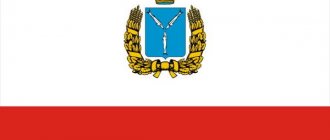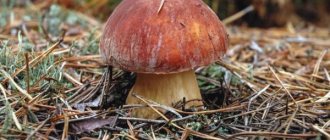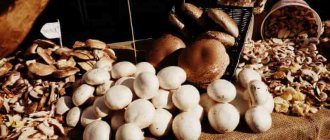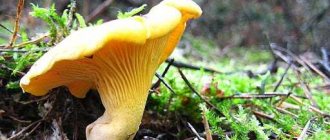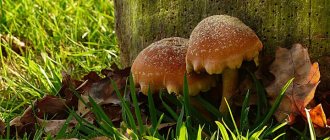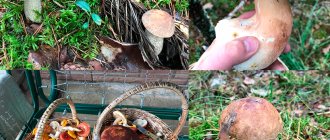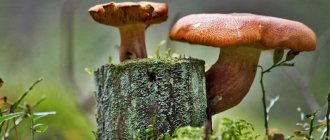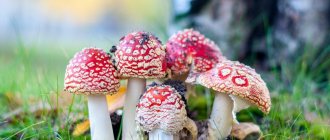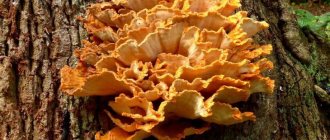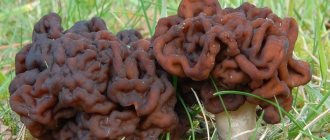Before considering all aspects of mushroom harvesting in the Rostov region, let's consider its usefulness. Wild mushrooms are a valuable food that helps diversify the menu from store-bought products. Healthy nutrition experts have determined that vitamins B and C, nicotinic and folic acids, calcium, phosphorus, potassium, and iron have a positive effect on the functioning of the cardiovascular and central nervous systems, strengthen bone tissue and have a beneficial effect on hematopoiesis. They even have an antitumor effect due to the lectin proteins they contain, which act as traps for tumor cells.
This forest delicacy is rich in protein and, as a product of plant origin, has no cholesterol. They contain carbohydrates in the form of dietary fiber, which is especially useful for patients with diabetes, helping to reduce blood glucose levels.
However, mushroom protein is more difficult to digest than animal protein. Therefore, you should not consume more than 150 g per day. But even such a mushroom portion will improve the taste of accompanying products (both vegetables and meat), increase the attractiveness of dishes with considerable health benefits.
Grilled mushrooms preserve the best nutrients because they cook faster than boiled mushrooms. Nutritionists also do not approve of frying in oil. And you should not eat these forest products raw, even elite boletus mushrooms or store-bought champignons - mushroom protein is better absorbed after heat treatment.
When “silent hunting”, one must take into account that mushrooms literally absorb harmful substances dissolved in soil waters. Collected near highways and industrial enterprises, they become dangerous due to their saturation with toxins and heavy metals. And don’t delude yourself that the specimen was found 100 meters from the road, where the noise of cars can no longer be heard. The mycelium can occupy a huge area and may well pump water with poisons dissolved in it from a roadside ditch.
Mushrooms of the Rostov region
Expert opinion
Melnikov Vladimir Mikhailovich
Knows 1000 ways to cook, pickle and marinate any types of mushrooms
Despite the rather dry climate, the mushroom population of the Rostov region is quite diverse, although some mushrooms that are widespread in the central and northern regions are much less common, for example, chanterelles. But in sunny places in the steppe, in meadows and clearings, almost 30 species of champignons grow.
In the northern regions, in forests and shelterbelts, even before the start of the mushroom season, in the spring you can find Judas ears, oyster mushrooms and frammulins, edible mushrooms, little known to mushroom pickers, which, however, require additional processing before cooking. From mid-summer, after the rains, everyone collects the familiar russula, milk mushrooms, boletus, mushrooms (boletus and aspen mushrooms), rows, honey mushrooms, even porcini mushrooms and saffron milk caps.
In addition to edible ones, many conditionally edible and poisonous species grow in the region. They all play an important role in the ecosystem, recycling organic waste and enriching the soil with useful substances. Therefore, you should not thoughtlessly destroy mushrooms that are not suitable for the basket. About forty representatives of the mushroom kingdom have already been listed in the Red Book of the Rostov Region, and not only the delicious black truffle and ram mushroom, but also inedible and even poisonous species.
Coat of arms and flag of the Rostov region
Birth of the Alexander Forest
The first plantings were planted in the 19th century, in 1876, on the lands of the Don Army as a way to combat drought, an attempt to soften the steppe climate and to increase agricultural productivity. The territory was expanding all the time. Currently, the Alexander Forest occupies more than 5.5 thousand hectares, of which more than four thousand hectares are occupied by forest plantations. These are various species of deciduous trees: oak, ash, aspen, alder, maple, acacia, mulberry, linden, birch. The forest area is surrounded by agricultural land.
The Alexander Forest has become a haven for many forest inhabitants. In the middle of the 20th century, the Lenin forestry was formed here, which is still thriving. Biological scientists work on its territory alongside rangers and foresters.
A huge area is open to all visitors. You can walk along most of it at any time. Tourists with tents often camp here.
Edible mushrooms
In special reference books, the list of edible species takes up several pages, but the safest way to collect is to first separate mushrooms into familiar and unfamiliar, and only then into edible and inedible. In this case, the list of “good” ones is sharply shortened. It retains those that are easiest to distinguish from their poisonous counterparts and that have the best taste.
Common champignon
Champignon
The most productive mushrooms in the Rostov region can be considered champignons, different types of which take advantage of all the natural features of this area and bear fruit throughout the summer. They are divided into five groups, each of which prefers a specific natural area: forest (they can only be found in forests), soil (preferring open, plant-free spaces), herbophiles (grow in grassy meadows).
The greatest species diversity of champignons is observed in steppes and forest-steppes. And the best harvest comes from rich forest and meadow humus. That is, they can be found in almost all natural areas of the Rostov region.
White mushrooms
Porcini
Experienced mushroom pickers distinguish between white, half-white and yellow mushrooms. White and semi-white ones have very conventional differences, and yellow boletus mushrooms are a little similar in color to boletus. All their varieties have a plump, stable stem and a round, thick cap up to 25 cm in diameter. In a good mushroom summer (i.e., warm and rainy), you can find porcini mushrooms in deciduous and mixed forests already at the beginning of summer. But the usual time for their collection is from July to October.
In all cuisines of the world, whites are considered a delicacy. They have a characteristic taste and aroma, which is enhanced by heat treatment. Moreover, they can be used even raw, simply by rinsing with water. But since nutritionists have found that heat treatment does not destroy the beneficial substances in mushroom pulp, but, on the contrary, promotes their better absorption, raw mushrooms have disappeared from salad recipes and side dishes.
Obabki
Obabok gray
This common name hides the boletus and boletus, which are clearly distinguishable from each other. They are similar in the shape of a large hemispherical cap, a tubular hymenophore (spore carrier), less dense in appearance than that of porcini mushrooms, a cylindrical stalk that thickens slightly downwards and white flesh that darkens when cut and when cooked.
Although mushroom pickers for some reason single out aspen boletuses and black-headed boletuses as being of higher quality, all boletuses belong to the category of “good edible mushroom.” Perhaps the reason for such preferences is that ordinary boletuses prefer wet lowlands and even moss grasses and are more often affected by worms than boletuses and black-headed boletuses growing in drier places.
Butter
They got their name because of the oily cap that is slippery to the touch. They grow on coniferous litter, near pine trees and spruce trees. They are valued by mushroom pickers for their excellent taste when fried or pickled. The skin of the cap is easily removed, revealing the yellowish flesh. The bottom of the cap is tubular.
Expert opinion
Melnikov Vladimir Mikhailovich
Knows 1000 ways to cook, pickle and marinate any types of mushrooms
Although there are inedible varieties of the mushroom, they are found only in Siberia. Therefore, the European oiler is an easily identified and always safe representative of the mushroom kingdom.
Butter
Bluelegs
Lilac-legged rower
This is how it is customary to call the purple-legged rows. They are very convenient for collecting - by attacking a mushroom spot, you can quickly fill the basket. Good fried. Before frying, they are usually soaked in cold water for some time to get rid of minor impurities.
Unfortunately, the most elite types of grebes (matsutake and Mongolian grebes) are not found in the European part of Russia, but among the poisonous grebes there are representatives of the family Grebes.
Real morel
Morels
They grow in mixed forests and shelterbelts next to coniferous trees, as they are very fond of fertile soil substrate made from rotted pine needles. They often grow up in families. Therefore, having encountered one specimen, it makes sense to look for its fellows nearby.
Ryzhik
Saffron milk caps
As great as porcini mushrooms are in stir-fries, saffron milk reigns among pickles. Particularly good are the small, crunchy saffron milk caps, which were once salted in bottles and pushed into a narrow neck.
Expert opinion
Melnikov Vladimir Mikhailovich
Knows 1000 ways to cook, pickle and marinate any types of mushrooms
The list of edible mushrooms that can be found in the Rostov region is not limited to these species. They also collect milk mushrooms and milk mushrooms (for salting), umbrellas (butts), oyster mushrooms, and, less often, chanterelles. However, you have the best chance of filling your basket with the listed representatives of the fungal kingdom.
Collection rules
The main period for the appearance of edible mushrooms is in early summer and autumn. It is important to remember that in particularly hot weather the larvae multiply quickly, which means the quality of the mushrooms will be low.
To go out into the wild, you need to prepare clothes that are appropriate for the temperature and protect against insects that are active this season.
To avoid insect bites, some mushroom pickers put on gardening gloves and go out “hunting” in the morning.
Collection points should be located away from roads and populated areas.
- It is advisable to have an illustrated reference book with you for a detailed comparison of fruiting bodies, paying special attention to the color change when broken, their smell and structure.
- You cannot pick specimens that are too young; they do not have all the characteristics that allow them to be unmistakably recognized. Fly agarics are often similar in appearance to sandpipers.
- To prevent the mycelium from drying out and bearing fruit in the future, after cutting, you need to carefully sprinkle the cut areas with earth. The collected product is processed during the first day, boiling for at least 20 minutes.
- Only familiar cap mushrooms that are beyond doubt of their edibility are collected; drying is allowed only for edible, non-worm-free mushrooms.
- Summer can be especially dangerous - poisonous steppe snakes appear during the dry season, so it is undesirable to go out in hot weather.
Precautionary measures
Mushroom pickers advise putting the caps in a ventilated container - a long absence of air and warming up can activate the synthesis of toxic substances that are not destroyed even during heat treatment.
It is better to refuse a plastic bag; a humid environment creates excellent conditions for the growth of mold, as well as pathogenic microorganisms and bacteria that are dangerous to health.
Fresh material requires immediate preparation.
Before cooking, you need to thoroughly clean the caps from soil and dust, soaking them in water for 10-15 minutes, then carefully remove the film or use a sponge to clean vegetables. In some cases, you can use a knife (cutting damaged areas, tips of legs, etc.)
Once boiled, they can be frozen, and the dried mass can be used to prepare aromatic mushroom seasonings for main dishes.
Inedible
The most correct thing is to classify all unfamiliar species as inedible. But recently, mycologists have classified greenfinch and pigweed, familiar from childhood, as conditionally edible. Although cases of poisoning have not yet been reported, scientists have determined that these mushrooms are more active than others in accumulating and retaining toxic substances from the soil and air.
So they can cause harm to health that is not immediately noticeable, but significant. But even speaking of “definitely edible”, it is recommended to collect young, strong specimens that simply have not had time to absorb harmful substances.
You should not eat wormy mushrooms - their taste will not please anyone, although they will not cause much harm. When the mushroom harvest is too small and it is a pity to throw away what is collected with slight signs of worminess, less affected specimens are sometimes left and kept for 1 hour in salted water.
Fisheries
The Alexander Forest (the Rostov region is rightfully proud of this protected area) is a wonderful place for fishing lovers. Not far from the bed of the Mokraya Chuburka River there are ponds, which are a private protected area. Fish are bred in the ponds: perch, bream, ram, carp, pike, roach, carp. Fishing here is paid, but the area is open for walking. Fishing competitions are held here, which are popular among fans of this activity. There is a rental of motor and rowing boats. There are special bridges along the shore for the convenience of fishermen and for organizing competitions. A huntsman can help with organizing fishing trips.
Poisonous
Poisonings with poisonous mushrooms occur in the Rostov region almost every year. But it is not the abundance of toxic species that is to blame for this, but the inattention and inexperience of mushroom pickers.
Death cap
Toadstool pale
A deadly representative of the fly agaric family. Unlike the usual fly agarics, it does not announce itself with a bright red or yellow cap with characteristic spots, but disguises itself as a honey mushroom or a dead row.
Be sure to have a good understanding of the lamellar species so as not to put this poisonous mushroom in the basket. If it was discovered only after disassembling the basket, then it is safer to throw away everything collected - the pale grebe may have time to share its poison with its neighbors and make them toxic.
The most dangerous thing is that the symptoms of poisoning do not appear immediately, and poisons can already cause irreparable harm to health, destroy the liver and make death inevitable.
Soap row (tricholoma)
It is quite easily identified by its sharp soapy smell. It comes across quite often, and although it does not have a strong toxic effect, it causes severe stomach upset.
Soap row
Ideal fly agarics for tincture
fly agaric
Very easy to identify. As they say - a classic of the genre.
And you should not trust stories about its safe use to achieve a hallucinogenic effect. This is a poisonous mushroom, the consumption of which can lead to death or at least irreversible damage to internal organs.
Gall or satanic mushroom
It tries to imitate a porcini mushroom, but it can be easily distinguished by its red stem with an orange tint.
Satanic mushroom
False honey fungus brick-red
False honey mushrooms
Honey mushroom lovers need to know very well the differences between edible honey mushrooms and their poisonous twins. If you are not sure, it is better not to collect honey mushrooms at all.
To be safe, you should leave it in the soil at the slightest suspicion of being a mushroom. But do not destroy, keeping in mind their undoubted benefits for the biocenosis.
Harvest photo:
Mushrooms in 2022 in the Rostov region, despite the limited quantity, can be collected by going in search of one of the mushroom places. However, you should not risk your health by collecting fruits that are questionable.
Mushroom places
Mushroom collection statistics have identified several places of the most productive “silent hunt” in the region and near the city of Rostov:
- Chertkovsky district;
- Tarasovsky district and surrounding areas;
- a forest strip running next to the Don River;
- pine plantings in the Millerovsky district;
- Semikarakorsky district;
- Shchepkinsky forest.
Features of the region
The Rostov region is located in the south of Russia. Despite the favorable climate, the forest fund is small - about 2.4% of the total territory. There are several bodies of water, including the Don River.
Forest plantations are artificial in nature and are designed to protect the soil from destruction. Forests, river banks, meadows, and the foothills of mountains are potential places for mushroom picking by lovers of “silent hunting,” of whom there are many in the region. Depending on the type of soil and the nature of the plantings, different types of mushrooms are collected.
There are many enterprises and factories in the region that destabilize the environmental situation. Therefore, the region is gradually becoming dangerous for “silent hunting”.
What is collected in different seasons
After the snow melts and the April sun begins to warm the earth, morels begin to emerge from last year’s rotten needles. These intricately shaped mushrooms do not like competition from other representatives of the mushroom kingdom and by the beginning of June they practically disappear.
Warm and rainy April will give mushroom hunting lovers a good harvest of champignons for the May holidays. If cold weather does not set in, in the first days of June you can go for whites. In July, you can even collect boletus, which is traditionally considered an autumn mushroom. In mid-July, the collection of saffron milk caps begins. But if the heat intensifies, then it is better to postpone mushroom hunting until August, when it becomes a little cooler at night - mushrooms grow worse in the summer heat.
Expert opinion
Melnikov Vladimir Mikhailovich
Knows 1000 ways to cook, pickle and marinate any types of mushrooms
The most fertile time for “quiet hunting” is autumn. Lilac-legged rowers are harvested from late summer until the first frost. Milk mushrooms and honey mushrooms love the November cool.
Let's sum it up
The mushroom places of the Rostov region are very extensive. With the arrival of the quiet hunting season in 2019, you can go in search of mushrooms in a proven forest area.
An attentive mushroom picker makes a good collection in the shady root areas of birch, hornbeam, oak and coniferous trees.
There is a lower chance of encountering harmful specimens in the fall, when myceliums bear fruit en masse under the influence of rainy weather.
It is advisable for beginners to go hiking with experienced people who know the names and descriptions of most mushrooms.
Mushrooms of the Rostov region from the Red Book
- Cladonia convoluta (Lam.) Cout.
- Magyar Cladonia – Cladonia magyarica Vain, ex Gyeln.
- Steppe cetraria – Cetraria steppae (Savicz) Kamefelt.
- Neofuscelia dark brown – Neofuscelia pulla (Ach.) Essl.
- Cartilaginous squamarine – Squamarina cartilaginea (With.) P. James.
- Squamarina lentigera (GH Weber) Poelt.
- Rough aspicilia – Aspicilia aspera (Mereschk.) Tomin.
- Bushy aspicilia – Aspicilia fruticulosa (Eversm.) Flagey.
- Bristle aspicilia – Aspicilia hispida Mereschk.
- Placolecanora alphoplaca (Wahlenb.) Rasanen.
- Toninia sedifolia (Scop.) Timdal.
- Fulgensia brilliant - Fulgensia fiilgens (Sw.) Elenkin.
- Steppe morel – Morchella steppicola Zerova.
- Coronal sarcosphere – Sarcosphaera coronaria (Jacq.) J. Schrot.
- Bernard's champignon – Agaricus bemardiiformis Bohus.
- Coastal champignon – Agaricus litoralis (Wakef. & A. Pearson) Pilat.
- Clay-yellow champignon – Agaricus lutosus (FH Moller) FH Moller.
- Champignon flake - Agaricus moellerianus Bon.
- Excellent champignon – Agaricus urinascens var. excellens (FH Moller) Nauta.
- Battarrea phalloides (Dicks.) Pers.
- Olivier's umbrella mushroom – Chlorophyllum olivieri (Barla) Vellinga.
- Floccularia rickenii (Bohus) Wasser ex Bon.
- Long-rooted white champignon – Leucoagaricus barssii (Zeller) Vellinga.
- Moser's white champignon – Leucoagaricus moseri (Wasser) Wasser.
- Pilate's white champignon – Leucoagaricus pilatianus (Demoulin) Bon & Boiffard.
- Semi-coastal white champignon – Leucoagaricus sublittoralis (Kiihner ex Noga) Singer.
- Vikhansky's white champignon – Leucoagaricus wichanskyi (Pilat) Bon & Boiffard.
- Badham's white dung beetle – Leucocoprinus badhamii (Berk. & Broome) Locq.
- Sandy Montanea – Montagnea arenaria (DC.) Zeller.
- Tulostoma kotlabae Pouzar.
- Pretty Tulostoma – Tulostoma pulchellum Sacc.
- Fly agaric - Amanita echinocephala (Vittad.) Qirel.
- Amanita vittadinii (Moretti) Sacc.
- Entoloma lividoalbum (Kuehn. & Romagn.) Kubicka.
- Hohenbuehelia petaloides (Bull.) Schulzer.
- Phellorinia herculeana (Pers.) Kreisel.
- Leucopaxillus lepistoides (Maire) Singer.
- Gray boletus – Leccinum duriusculum (Schulzer ex Kalchbr.) Singer.
- Gastrosporium simplex – Gastrosporium simplex Mattir.
- Melanogaster variegatus (Vittad.) Tul. & C. Tul.
- Pisolithus arhizus (Scop.) Rauschert.
- Starwort corolla – Geastrum corollinum (Batsch) Hollos.
- Starwort - Geastrum fomicatum (Huds.) Hook.
- False-striped starwort – Geastrum pseudostriatum Hollos.
- Saccular starwort – Geastrum saccatum Fr.
- Myriostoma perforated – Myriostoma coliforme (Dicks.) Corda.
- Canine mutinus – Mutinus caninus (Huds.) Fr.
- Varnished tinder fungus – Ganoderma lucidum (Curtis) P. Karst.
- Root-loving polypore – Polyporus rhizophilus (Pat.) Sacc.
Where to stay
As mentioned above, Alexander Forest is a favorite vacation spot for Rostovites and residents of nearby areas. To make your stay more comfortable, there are many guest houses on the hunting grounds where you can find shelter for a few nights. The cost of living will depend on the number of amenities that guests want to use, but you can find an economy-style overnight stay by staying with a large group in a house without special amenities, or you can stay in equipped cottages located on the territory of the equestrian club. The cost will vary from 200 rubles for a bed in a trailer with amenities on the street, to 1,500 rubles for a bed in a room with amenities.
Spending the night in a protected area in a tent will cost 100-200 rubles per person. Thus, Alexander Forest is a recreation center where you can find many accommodation options for any level of needs.
